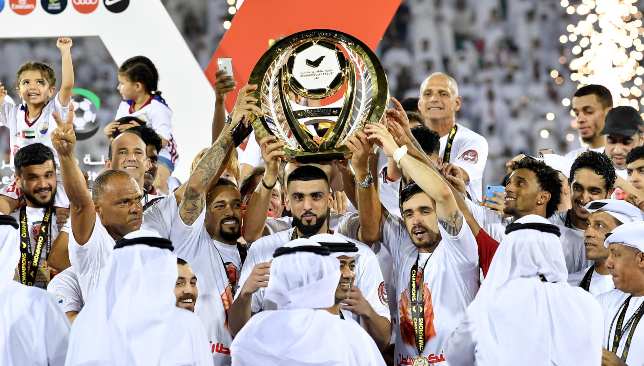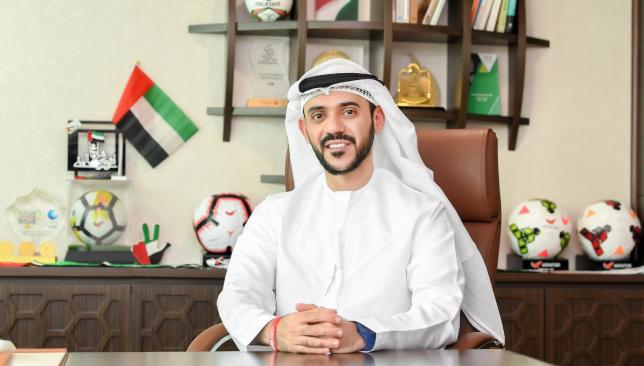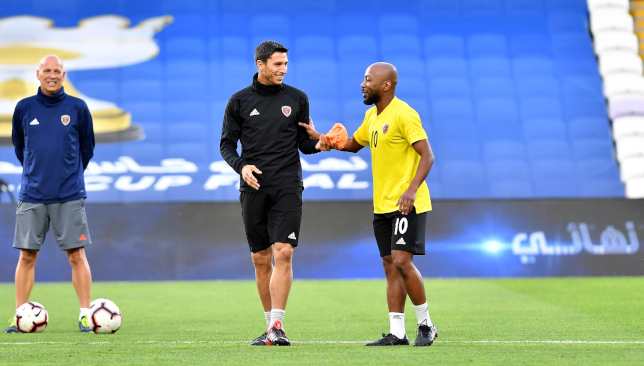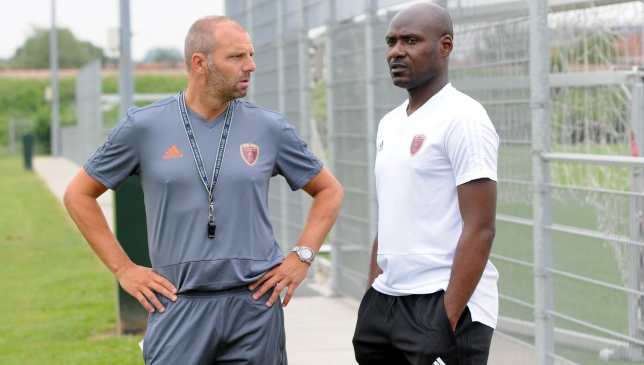
The year is 1973. The United Arab Emirates is just two-years-old. The Dirham is launched and the first traffic lights come into operation in Abu Dhabi. The UAE’s maiden top-flight football campaign also gets the green light, with Sharjah – or Al Oruba back then – the inaugural UAE Football League champions.
There were only three teams and three games played in the maiden 1973/74 campaign, but everything starts somewhere. Joining Oruba were Al Ahli Football Club – Dubai (now Shabab Al Ahli Dubai Club) and Oman Club (now Emirates Club). All three still exist today.
Just over a decade ago is when things really began to take off. In 2007 the Pro League Committee was formed and the 2008/09 UAE Pro League season was the dawn of the professional era.
The 2019/20 campaign – and 46th in total – kicked off in September with Sharjah again the team to beat. Last term brought their sixth title, but first in 23 years. It is the 12th season since professionalism, and the league has come a long way.
From an influx of cash attracting big name players and coaches – which has in turn propelled the national team to finish third at a continental tournament and spawned local superstars known beyond the confines of this sandy corner of the globe – to finally embracing social media. The Arabian Gulf League has taken huge strides forward.
“It has been a journey of rise and rise,” insists PLC CEO Waleed Al Hosani, talking to Sport360.
“A steady progress towards becoming one of the top domestic competitions in Asia and beyond. Of course, there have been ups and downs but, looking back, the overall trend has been one of constant improvement.”

PLC CEO Waleed Al Hosani says the AGL has come a long way, but can always improve.
From leading lights who illuminated Europe and other grand stages before seeking fortune, if not fame, in the desert, to the rise of the national team following a coming out party at the 2012 Olympic Games, the progress is tangible.
Asamoah Gyan, Mirko Vucinic, Marcus Berg and Alvaro Negredo have all plied their trade here. Those who have graced the dugout are even more iconic, like lionised Argentine Diego Maradona, who managed Fujairah as recently as 2018. Zlatko Dalic, who led Croatia to the World Cup final a year ago, Cesare Prandelli and Hector Cuper have all coached teams in the professional era.
The UAE national team reached the 1990 World Cup and peaked in the FIFA rankings at No42 in 1998 before a precipitous fall – culminating in their lowest ebb in 2011, plummeting 90 places to 132.
Then, the rise. U23 coach Mahdi Ali took a vibrant young side started to London 2012. They failed to win a game in a tough group containing hosts Great Britain – who had Ryan Giggs and Daniel Sturridge in their ranks – as well as Luis Suarez and Edinson Cavani-led Uruguay and Sadio Mane’s Senegal.
But rough diamonds like Omar Abdulrahman and Ali Mabkhout caught the eye – the former earning a trial at and subsequent offer from Manchester City, which he turned down.
It led to a spotlight intensifying on ‘Amoory’ and the ‘Golden Generation’ – he was named Asia’s best player in 2016; usurping compatriot Ahmed Khalil who won in 2015 – as well as increased exposure for the AGL. The UAE followed up by being crowned 2014 Gulf Cup victors then beating champions Japan in the 2015 Asian Cup quarter-finals, eventually finishing third.
This success and progress has grown from the seeds of professionalism planted.
“When the Pro League was launched in 2008, the national team had been eliminated from the group stage in the two previous Asian Cups,” added Al Hosani.
“Fast forward to today, we are back-to-back Asian Cup semi-finalists and two Emirati players have won the Asian Player of the Year award.
“There are many factors behind this, but a strong professional league where the players live a professional lifestyle, learn from some world-class coaches and rub shoulders with foreign players with bags of European and international experience has to be up there among the biggest.”

Sebastian Tagliabue (c) is the AGL’s leading foreign scorer ever and among the longest serving players too. Wahda team-mate Ismail Matar (r) has played longer than anyone in the league.
Reigning champions Sharjah – fittingly nicknamed the King – were the fifth team of the modern era coronated last season. Al Ain have lifted the most titles (four) followed by Shabab Al Ahli (three). Abu Dhabi kingpins Al Jazira and Al Wahda have two and one respectively.
Khalil, with 48 goals from 103 caps since 2008, is his country’s third-highest goalscorer. The 28-year-old is also one of the most decorated domestic club players – the only one to win four league championships since professionalism (three with Ahli in 2007/08, 08/09 and 13/14 and one with Al Ain in 17/18) began.
Abdulsalem Jumaa also has four – three with his beloved Wahda in 1998/99, 2000/01 and 2009/10, one the following year after moving across Abu Dhabi to Jazira.
The 42-year-old is one of the most respected figures in UAE football – having won 49 caps for the Whites during a 19-year club career that ended at Al Dhafra in 2016.
Now team manager at Wahda, he stands in the unique position of having straddled the divide of pre and post-professionalism. And he believes young Emirati players can only benefit from being in a league where standards are constantly rising.
Asked how far the AGL has come, Jumaa said: “Being honest, it is the mentality that has changed. They are young players now and there is a different mentality. I hope we will push them to be good players, not only in the UAE, but outside too.
“Everybody works to improve this mentality, from academy to first team, to federation and national team. But we need a little more time. It’s not easy to change from amateur to professional. A lot of countries are in front of us but I think we are going to reach something.
“I think we are improving and looking forward as a federation and PLC to the future, to make a better league.”
Jumaa’s title success is a stick he often uses to poke the Clarets’ evergreen, as well as ever-scoring, striker Sebastian Tagliabue with.
The Argentine, 34, has gone against the grain in terms of the UAE, and AGL, being a transient market where people come to feather their nest before flying back out into the real world.
Like many other foreign players, Tagliabue has flitted around various clubs in the Middle East – scoring prolifically in stints at Ettifaq and Al Shabab Riyadh in Saudi Arabia.
But he has made himself at home in Abu Dhabi. He could virtually be considered Emirati having spent a fifth of his life here. The Buenos Aires native is embarking on his seventh season at Wahda. His family love Abu Dhabi, his youngest son Gustavo was born there.
And unlike many expatriates, Tagliabue has made the most of his time here, and certainly contributed to the development of both the AGL and football. He recently overtook Gyan as the league’s top-scoring foreign player – netting an incredible 143 AGL goals in 145 league games as a Claret. He was even on the verge of qualifying to play for the UAE last year, before red tape scuppered his dream.

Abdulsalam Jumaa returned to Wahda – where he won three league titles as a player – as team manager this summer.
He has seen local talent make great strides but thinks there are higher climes to reach.
He said: “When I arrived in Saudi 10 years ago the Saudi league was, say, 10 points out of 11. The UAE was five points and Qatar, two points.
“Saudi has come a little down maybe, eight points, but the UAE and Qatar are growing. Seven points for UAE and maybe five for Qatar. The UAE, with the local players, they have something. They have amazing players, they are almost professional. When they truly come to the professional level, the UAE is in for big things.”
As well as being the record foreign scorer, he is also among the longest-serving in the professional era – not only among imports, but overall.
His six years and four-month tenure is the joint fifth longest. Only nine players have played longer, with team-mate Ismail Matar, 36, in his 19th season. All of them spent with Wahda.
There remain gaps to other Gulf and Asian leagues. The AGL might have closed those gaps in many ways, but not in others.
It is something Al Hosani is keen to point out, that constant improvement he talks about being the driving force going forward.
There is a chasm to bridge to the AGL’s top competitors in Asia, like China to the east, and closer to home too. The Saudi Professional League and Qatar Stars League are pulling ahead.
👑🏆🔓🏟️
— Arabian Gulf League (@AGLeague_EN) September 11, 2019
↘️
🏆
↗️
🔴🏆🔓🏟️#MatchOfChampions#AGSuperCup@SharjahFC @Shabab_AlAhliFC pic.twitter.com/88f9AmScHT
The AGL lags behind alarmingly in terms of market value compared to the Chinese Super League – although this is hardly surprising considering the astronomical amounts of money being pumped into new super teams like Guangzhou Evergrande and Shanghai SIPG. Fabio Cannavaro, Rafael Benitez, Jordi Cruyff and Roberto Donadoni are managing in the CSL this season. Marek Hamsik, Javier Mascherano, Marouane Fellaini, Hulk and Oscar are a clutch of stars caught in the swollen net its riches has reeled in.
According to transfermarkt.com the total market value of the CSL is £459.41m – comfortably No1 in Asia. The AGL is ranked just sixth at £138.71m – trailing Japan’s J1 League (£311.49m), the SPL (£299.39m), QSL (£162.54m) and South Korea’s K League (£148.16m).
This is despite record transfer sums regularly shelled out since professionalism and rising almost year on year. Since Brazilian attacking midfielder Fernandinho arrived at Jazira in 2012 for £4.05m, the record has been smashed five times – Moussa Sow’s August 2015 move to Ahli for £14.40m the current mark.
Things are moving in the right direction but there is still a lot of room for improvement. Like capitalising on interest in foreign imports. The AGL has noticeably polished its online presence in the last year and launched its English Twitter last August – eight years after the Arabic version went live.
Al Hosani added: “Outside the pitch, we have seen how foreign players raised the profile of the league. For example, when Gyan came from the Premier League, it made international headlines and overnight fans in Ghana and England were following news about UAE football.
“Likewise when foreign players make a big money move from here to Europe, it sheds light on the league, as was the case with Manuel Lanzini joining West Ham or Caio moving to Benfica.
“When a player is a superstar in his home country and he moves to the AGL, it brings a lot of interest from that country; we saw it with Balazs Dzsudzsak from Hungary.”
The AGL is a growing beast, and it remains hungry.